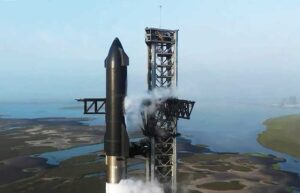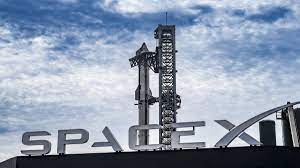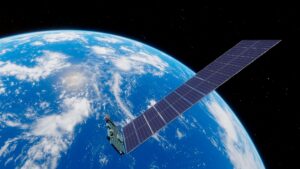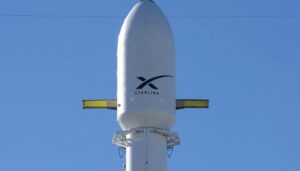
The fifth test launch of the US Starship rocket system under development for manned missions to the Moon and Mars on Sunday was a success, the development company SpaceX said.
After one orbit around the Earth, the promising Starship manned spacecraft touched down in the Indian Ocean northwest of Australia.
The launch was carried out from SpaceX’s Starbase launch pad in Boca Chica, southeast Texas, at 08:25 a.m. ET (15:25 a.m. Kyiv time).
Meanwhile, for the first time in the history of space exploration, the Super Heavy carrier has successfully landed back at the launch complex, where it was grabbed by the Mechazilla system levers during landing.
The reusable rocket system consists of the Starship spacecraft and the Super Heavy launch vehicle. Its height exceeds 120 meters. It is taller than any other rocket ever created in the world. The Super Heavy carrier is twice as powerful as the Space Launch System (SLS) heavy rocket being developed by NASA for manned flights to the Moon. The rocket has been launched four times before, but only two flights – in March and June of this year – were successful.

The Falcon 9 launch vehicle on Saturday successfully put into orbit another batch of 23 mini-satellites to replenish the orbital constellation of the Starlink system’s global Internet coverage network, developer SpaceX said.
“The launch of 23 Starlink satellites has been confirmed,” the statement said.
The rocket was launched from Launch Complex 39A of the Kennedy Space Center at Cape Canaveral in Florida on Friday at 20:21 US East Coast time (Saturday at 02:21 Kiev time). About an hour later, the satellites were put into orbit.
Since May 2019, SpaceX has already launched more than 6 thousand such satellites under the Starlink project. Some of them failed or went out of orbit. More than 5.6 thousand vehicles are in orbit in working condition.
During the launch, the first reusable stage of the launch vehicle, which was used for the 19th time, after separation made a controlled vertical landing on the offshore drone platform A Shortfall of Gravitas, which was located in the Atlantic.

A Falcon rocket has successfully launched another batch of 23 mini-satellites to replenish the orbital grouping of the Starlink global Internet coverage network, the SpaceX development company has announced.
“The launch of 23 Starlink satellites has been confirmed”, the company said in a statement.
The rocket was launched from the 40th launch complex at the US Space Force base at Cape Canaveral in Florida on Saturday at 22:17 US East Coast time (Sunday at 05:17 Kyiv time).
This is the 118th launch of Internet satellites since May 2019 as part of the Starlink project and the 49th since the beginning of this year. SpaceX has already launched more than 5.3 thousand such satellites into orbit. Some of them have failed or left the orbit. Almost 5 thousand vehicles remain in orbit in working condition.
As part of the launch, the first reusable stage of the launch vehicle, which was used for the fourth time, made a controlled vertical landing on the A Shortfall of Gravitas drone platform in the Atlantic after separation.
The company is now the largest satellite operator in the world. Starlink’s Internet network is available to users in 62 countries, including North and South America, Europe, Asia, Africa, and Australia. According to the Pentagon, the US military is also actively using the services of these satellites.
In the future, SpaceX plans to deploy an orbital grouping of 12 thousand spacecraft (and later – 30 thousand) to create a full-scale network that will provide the world’s inhabitants with broadband Internet access anywhere in the world. The total investment in the project is estimated at $10 billion.

A Falcon 9 rocket has successfully launched another batch of 22 mini-satellites into orbit to replenish the orbital grouping of the Starlink global Internet coverage network, the SpaceX development company has announced.
“The launch of 22 Starlink satellites has been confirmed,” the company said in a statement.
The rocket was launched from the 40th launch complex at the US Space Force base at Cape Canaveral in Florida on Friday at 22:00 US East Coast time. About an hour after the launch, the satellites were placed into orbit.
This is the 112th launch of Internet satellites since May 2019 as part of the Starlink project and the 43rd since the beginning of this year. With the current launch, SpaceX has already launched 5.2 thousand such satellites into orbit. Some of them have failed or gone out of orbit. More than 4.8 thousand vehicles remain in orbit in working order.
As part of the launch, the first reusable stage of the launch vehicle, which was used for the 10th time, made a controlled vertical landing on the A Shortfall of Gravitas offshore drone platform in the Atlantic after separation.
SpaceX is currently the largest satellite operator in the world. The Starlink Internet network is available to users in 62 countries, including North and South America, Europe, Asia, Africa, and Australia. According to the Pentagon, the US military is also actively using the services of these satellites.
In the future, SpaceX plans to deploy an orbital grouping of 12 thousand spacecraft (and later – 30 thousand) to create a full-scale network that will provide the world’s inhabitants with broadband Internet access anywhere in the world. The total investment in the project is estimated at $10 billion.

The launch of a Falcon 9 rocket with the next batch of 54 mini-satellites to replenish the orbital constellation of the Starlink system’s global Internet coverage network, scheduled for Friday, was canceled 40 seconds before liftoff, developer SpaceX said.
No reason was reported. The backup launch date is Saturday, July 15.
This is Starlink’s 94th internet satellite launch since May 2019 and its 25th since the beginning of this year. SpaceX has already put more than 4,700 of these satellites into orbit. Some of them failed or went out of orbit. More than 4.4 thousand devices remain in orbit in working condition.
The first reusable stage of the launch vehicle, which is being used for the 16th time, will have to make a controlled vertical landing after separation on the offshore drone platform A Shortfall of Gravitas, located 642 kilometers from the spaceport in the Atlantic.

The Falcon 9 rocket will launch into orbit on Friday with another batch of 54 mini-satellites to replenish the orbital constellation of the Starlink system’s global Internet coverage network, developer SpaceX said.
The launch will take place from Launch Complex 40 at the U.S. Space Force base at Cape Canaveral in Florida on Sunday at 00:40 U.S. East Coast time (7:40 a.m. QST).
This is Starlink’s 94th internet satellite launch since May 2019 and its 25th since the beginning of this year. SpaceX has already put into orbit more than 4.7 thousand such satellites. Some of them failed or went out of orbit. More than 4.4 thousand devices remain in orbit in working condition.
The first reusable stage of the launch vehicle, which is being used for the 16th time, will have to make a controlled vertical landing on the offshore drone platform A Shortfall of Gravitas, located in the Atlantic.